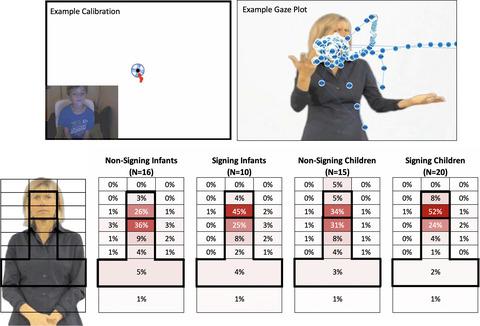Our official English website, www.x-mol.net, welcomes your
feedback! (Note: you will need to create a separate account there.)
Rapid development of perceptual gaze control in hearing native signing Infants and children
Developmental Science ( IF 3.1 ) Pub Date : 2021-01-23 , DOI: 10.1111/desc.13086 Rain G Bosworth 1 , Adam Stone 2
Developmental Science ( IF 3.1 ) Pub Date : 2021-01-23 , DOI: 10.1111/desc.13086 Rain G Bosworth 1 , Adam Stone 2
Affiliation

|
Children's gaze behavior reflects emergent linguistic knowledge and real-time language processing of speech, but little is known about naturalistic gaze behaviors while watching signed narratives. Measuring gaze patterns in signing children could uncover how they master perceptual gaze control during a time of active language learning. Gaze patterns were recorded using a Tobii X120 eye tracker, in 31 non-signing and 30 signing hearing infants (5–14 months) and children (2–8 years) as they watched signed narratives on video. Intelligibility of the signed narratives was manipulated by presenting them naturally and in video-reversed (“low intelligibility”) conditions. This video manipulation was used because it distorts semantic content, while preserving most surface phonological features. We examined where participants looked, using linear mixed models with Language Group (non-signing vs. signing) and Video Condition (Forward vs. Reversed), controlling for trial order. Non-signing infants and children showed a preference to look at the face as well as areas below the face, possibly because their gaze was drawn to the moving articulators in signing space. Native signing infants and children demonstrated resilient, face-focused gaze behavior. Moreover, their gaze behavior was unchanged for video-reversed signed narratives, similar to what was seen for adult native signers, possibly because they already have efficient highly focused gaze behavior. The present study demonstrates that human perceptual gaze control is sensitive to visual language experience over the first year of life and emerges early, by 6 months of age. Results have implications for the critical importance of early visual language exposure for deaf infants. A video abstract of this article can be viewed at https://www.youtube.com/watch?v=2ahWUluFAAg.
中文翻译:

听原生手语的婴幼儿感知凝视控制的快速发展
儿童的注视行为反映了新兴的语言知识和语音的实时语言处理,但对观看签名叙述时的自然注视行为知之甚少。测量手语儿童的注视模式可以揭示他们在主动语言学习期间如何掌握感知注视控制。使用 Tobii X120 眼动仪记录注视模式,在 31 名非手语和 30 名手语听力婴儿(5-14 个月)和儿童(2-8 岁)观看视频中的手语叙述时记录。通过在视频反转(“低可懂度”)条件下自然呈现它们来操纵签名叙述的可理解性。使用这种视频处理是因为它扭曲了语义内容,同时保留了大多数表面语音特征。我们检查了参与者的视线,使用具有语言组(非签名与签名)和视频条件(正向与反向)的线性混合模型,控制试用订单。非手语婴儿和儿童更喜欢看面部以及面部下方区域,这可能是因为他们的目光被吸引到手语空间中移动的咬合架上。本机手语婴儿和儿童表现出有弹性、专注于面部的凝视行为。此外,他们的注视行为在视频反转签名叙述中没有变化,类似于成年本土手语者所看到的,可能是因为他们已经具有高效的高度集中注视行为。本研究表明,人类感知凝视控制在生命的第一年对视觉语言体验很敏感,并且在 6 个月大的时候就出现了。结果对聋儿早期视觉语言暴露的关键重要性产生了影响。可以在 https://www.youtube.com/watch?v=2ahWUluFAAg 上查看本文的视频摘要。
更新日期:2021-01-23
中文翻译:

听原生手语的婴幼儿感知凝视控制的快速发展
儿童的注视行为反映了新兴的语言知识和语音的实时语言处理,但对观看签名叙述时的自然注视行为知之甚少。测量手语儿童的注视模式可以揭示他们在主动语言学习期间如何掌握感知注视控制。使用 Tobii X120 眼动仪记录注视模式,在 31 名非手语和 30 名手语听力婴儿(5-14 个月)和儿童(2-8 岁)观看视频中的手语叙述时记录。通过在视频反转(“低可懂度”)条件下自然呈现它们来操纵签名叙述的可理解性。使用这种视频处理是因为它扭曲了语义内容,同时保留了大多数表面语音特征。我们检查了参与者的视线,使用具有语言组(非签名与签名)和视频条件(正向与反向)的线性混合模型,控制试用订单。非手语婴儿和儿童更喜欢看面部以及面部下方区域,这可能是因为他们的目光被吸引到手语空间中移动的咬合架上。本机手语婴儿和儿童表现出有弹性、专注于面部的凝视行为。此外,他们的注视行为在视频反转签名叙述中没有变化,类似于成年本土手语者所看到的,可能是因为他们已经具有高效的高度集中注视行为。本研究表明,人类感知凝视控制在生命的第一年对视觉语言体验很敏感,并且在 6 个月大的时候就出现了。结果对聋儿早期视觉语言暴露的关键重要性产生了影响。可以在 https://www.youtube.com/watch?v=2ahWUluFAAg 上查看本文的视频摘要。











































 京公网安备 11010802027423号
京公网安备 11010802027423号